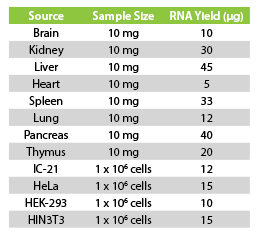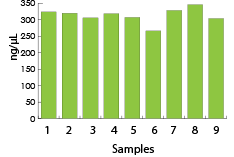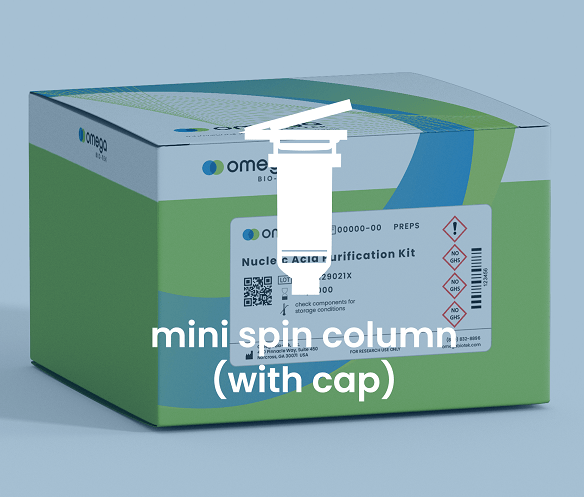The E.Z.N.A. Total RNA Kit I provides a simple and rapid method for the isolation of up to 100 μg total RNA from cultured eukaryotic cells and soft tissues. Multiple samples of up to 1 x 107 eukaryotic cells or 30 mg of tissue can be processed in parallel in fewer than 20 minutes. Many different sample types can be used, including kidney, liver, heart, spleen, lung, pancreas, thymus, HeLa cells, HEK-293 cells, and HINT3T3 cells. After the homogenization process, samples are applied to the HiBind® RNA Mini Column which binds total RNA. Cellular debris and other contaminants are effectively washed away after a few quick wash steps. Total RNA greater than 200 nt is isolated using this kit. Purified RNA can be used in many downstream applications such as RT-PCR, qRT-PCR, Northern blotting, nuclease protection assay, microarrays, in-vitro translation, and Next Generation Sequencing.
For Research Use Only. Not for use in diagnostic procedures.
| FEATURES | SPECIFICATIONS |
|---|---|
| Downstream Application | PCR, qPCR, real-time RT-PCR, microarray, Northern blot, poly-A purification |
| Elution Volume | 40-70 μL |
| Starting Material | Cultured eukaryotic cells and soft tissues |
| Starting Amount | < 1 x 107 cells or 30 mg tissue |
| RNA Yield | Up to 100 µg |
| Processing Mode | Manual, centrifugation/vacuum |
| Throughput | 1 – 24 |
| RNA Binding Technology | Silica Mini spin column |
| Binding Capacity | 100 µg |
| ITEM | AVAILABLE SEPARATELY |
|---|---|
| HiBind® RNA Mini Columns | — |
| 2 mL Collection Tubes | View Product |
| TRK Lysis Buffer | View Product |
| RNA Wash Buffer I | View Product |
| RNA Wash Buffer II | View Product |
| Nuclease-free Water | — |
Yield from Mouse Tissue

Figure 1. Expected RNA yields from mouse tissue samples and cultured cell types with E.Z.N.A.® Total RNA Kit I.
Yield from HEK-239 Cells

Figure 2. Total RNA was isolated from 2.5×106 HEK-293 cultured cells with Omega Bio-tek’s E.Z.N.A.® Total RNA Kit I with an elution volume of 50 µL. RNA concentrations were quantified with Thermo Scientific’s NanoDrop® 2000c. RNA quality was assessed with the Agilent TapeStation® 2200.
FAQs
Can samples be stored in TRK Lysis Buffer prior to extraction?
Homogenized tissue/cell lysates in TRK Lysis Buffer can be stored at -80 °C for at least 6 months. To proceed with the frozen lysates, thaw the sample at 37 °C until they are completely thawed, and all salts in the lysis buffer are dissolved. Do not extend the treatment in 37 °C because it can cause chemical degradation of RNA.
I have been getting low 260/230 ratios with my samples. Is there a way to improve this?
Low A260/A230 ratio alludes to salt carryover (guanidine salt is not completely washed off during wash steps). Typically increasing the wash steps improves this ratio – so instead of 2 RNA Wash Buffer II wash steps, do 3.
Is there a way to isolate miRNA using the E.Z.N.A. Total RNA Kit I?
To bind RNA <200 nt, they would need to modify the binding step by adding 1 volume of 100% ethanol (instead of 70% ethanol in Step 5, Page 14, and Step 5, Page 19), and rest of the steps remain as-is. This modification helps bind miRNA along with large RNA and will get co-extracted in the same fraction.
Can I use the E.Z.N.A. Total RNA Kit I for tissues or cells stored in RNAlater™?
The RNAlater will interfere with our buffer chemistry resulting in low yields, so tissues must be washed prior to starting the extraction.
- Spin down the tissue at 500 x g for 5 minutes.
- Aspirate out the supernatant.
- Spin down the sample again (500 x g for 5 minutes), then aspirate out the supernatant.
- Use the pelleted cells or tissue for extraction following the E.Z.N.A. Total RNA Kit I Protocol – Culture Cells on page 11 or E.Z.N.A. Total RNA Kit I Protocol – Animal Tissue on page 17.
Product Information
Safety Data Sheets
| Components | Hazard Standards | Languages | Link |
|---|---|---|---|
| Nuclease-free Water | GHS | Spanish | |
| Nuclease-free Water | REACH | Greek | |
| Nuclease-free Water | REACH | Portuguese | |
| Nuclease-free Water | REACH | Hungarian | |
| Nuclease-free Water | REACH | Dutch | |
| Nuclease-free Water | WHMS | French | |
| Nuclease-free Water | WHMS | English | |
| Nuclease-free Water | REACH | Swedish | |
| Nuclease-free Water | REACH | Spanish | |
| Nuclease-free Water | REACH | Italian | |
| Nuclease-free Water | GHS | English | |
| Nuclease-free Water | REACH | English | |
| Nuclease-free Water | REACH | Danish | |
| Nuclease-free Water | REACH | French | |
| Nuclease-free Water | REACH | Norwegian | |
| Nuclease-free Water | REACH | German | |
| Nuclease-free Water | REACH | Finnish | |
| RNA Wash Buffer I | GHS | English | |
| RNA Wash Buffer I | WHMS | French | |
| RNA Wash Buffer I | WHMS | English | |
| RNA Wash Buffer I | REACH | Swedish | |
| RNA Wash Buffer I | REACH | Spanish | |
| RNA Wash Buffer I | REACH | Norwegian | |
| RNA Wash Buffer I | REACH | German | |
| RNA Wash Buffer I | GHS | Spanish |

